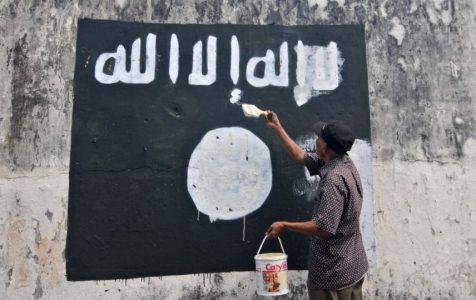
Indonesia is Islamic State’s new frontline
For a long period during last week’s 36-hour stand-off at Indonesia’s paramilitary Police Mobile Brigade (Brimob) headquarters, scores of rioting militants were in charge of a massive cache of automatic weapons and thousands of rounds of ammunition.
According to sources familiar with what transpired, the only reason the siege didn’t turn into a pitched gun-battle with police was that the leaders of the uprising lost contact with three coordinators outside the prison, known only as Deden, Ronggo and Ilham.
Who they were and what was planned remains unclear, but they were almost certainly members of Jamaah Ansharut Daulah (JAD), the Islamic State (ISIS) affiliate which engineered the uprising and was responsible for a subsequent wave of bombings in the port city of Surabaya that left 13 bombers and 12 civilians dead.
National police chief Tito Karnavian said there was little doubt the events were connected, signaling the emergence of a cell-based organization that may be more dangerous than the Al Qaeda-linked Jemaah Islamiyah network that terrorized the country in the early 2000s.
In the days since, Indonesian police lost one of their own in killing four sword-wielding men who attacked the Riau, Sumatra, provincial police headquarters in Pekanbaru on May 16, adding to two others shot earlier in one of a mounting series of raids across the country.
If any doubts were left after the last year’s five-month siege of the southern Philippine city of Marawi, the recent events in Indonesia have demonstrated that while the ISIS caliphate may have been effectively destroyed, its reach and influence in Southeast Asia has not.
Instigated by Wawan Kurniawan, 42, a prominent JAD militant from Sumatra, the May 9-10 prison riot led to the savage murder of five Detachment 88 counterterrorism officers and seizure of the arms cache in an unsecured room adjoining the temporary detention center.
According to a police accounting seen by Asia Times, the cache included 59 automatic rifles, 29 pistols, 11,000 rounds of 7.62 mm and 10,000 rounds of 5.52 mm ammunition, and boxes of bullets for everything from .22 to .45 caliber pistols.
The militants were initially able to connect to social media, with the first news of the riot appearing on ISIS’s Amaaq news agency and video from inside the jail later being uploaded to Instagram.
It took time for police to activate a signal scrambler, which explains the militants’ subsequent breakdown in communications with the outside.
Like Kurniawan, only 40-50 of the 156 prisoners were considered hard-core extremists; many of the inmates on trial or awaiting trial in the three cell blocks were possible candidates for de-radicalization, but little effort had been made to screen them all.
JAD founder Aman Abdurrahman, who was being held in a more secure part of the same prison, is currently on trial for directing an attack in central Jakarta in early 2016 from the high-security Nusakambangan island prison off Java’s south coast.
The stand-off finally ended after Abdurrahman was reportedly persuaded to record a surrender plea and police overwhelmed Kurniawan and nine other hold-outs in a hail of gunfire after cutting off power, food and water.
As violence and arrests continued in West and East Java and Sumatra, President Joko Widodo pledged to issue a presidential regulation if Parliament fails to pass an early revision to the 2003 Anti-Terrorism Law to give police greater powers of arrest and detention.

Police chief Karnavian has said he wants military intelligence to help in investigating JAD “down to its roots,” as Widodo put it, but there is likely to be strong opposition to legislating an additional role for the armed forces in the counterterrorism effort.
Instead of Afghanistan war veterans who made up the core of Jemaah Islamiyah, JAD is a collection of home-grown jihadi groups, among them dependents who are clearly as dedicated to the ISIS cause as the militants themselves.
Proof of that is in the three families, including mothers and children, who carried out the suicide attacks on three Surabaya Christian churches and the city’s police headquarters, and triggered the blasts that rocked a low-cost apartment block in the city’s southern suburb of Sidoarjo.
Police reports that the six family members behind the church attacks were recent returnees from Syria turned out to be false. But there are still serious concerns whether enough is being done to monitor or rehabilitate the 500 Indonesians known to have come back so far.
Another 600 are still unaccounted for, but scores of fighters may have died in the final desperate days before the collapse of ISIS’ caliphate and their dependents could still be in detention camps along the Turkish border.
JAD is expected to see the Surabaya attacks as a model for future operations against security forces, still their main target, and to continue its campaign of terror against Christian congregations and other ethnic and religious minorities.
Instead of the bulkier pressure cooker device favored so far, the Surabaya attackers assembled scores of pipe-bombs, easier to conceal but packed with high-explosive TATP, or acetone peroxide, made from readily available retail products.
The sustained level of violence has put police on edge with the Ramadan fasting period beginning today and ISIS well known for perversely convincing its followers that carrying out attacks during the Islamic holy month brings extra merit.
Source: Atimes






You must be logged in to post a comment.